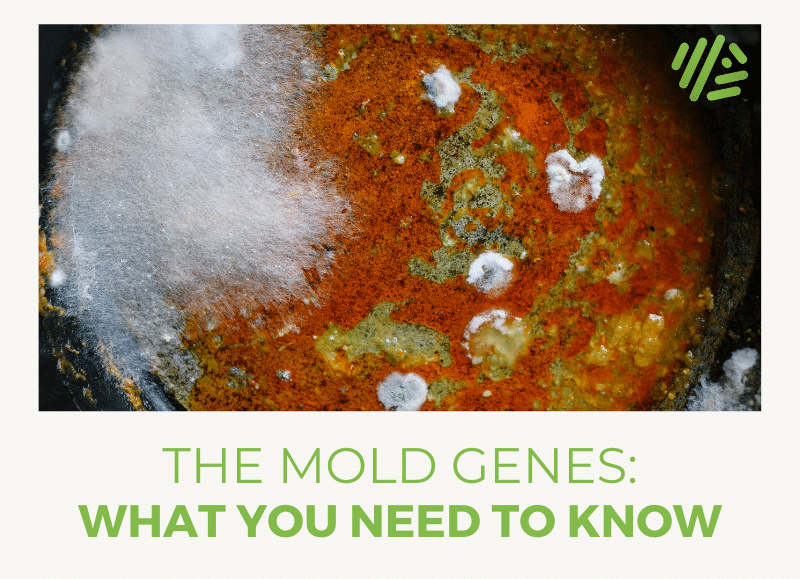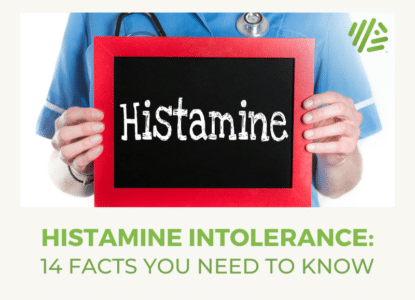Mold Genes: Do We Inherit Mold Toxicity?

The fuzzy weblike structures formed by molds are a common sight, which is not surprising given that the number of identified mold species number in the thousands. While off-putting mold (and other microbes) are vital to life, a fact which Louis Pasteur knew well:
Life would not long remain possible in the absence of microbes.
The vast majority of these molds are entirely harmless. However, some species of mold can make people very ill. This is of particular interest to me at the moment as we are in the middle of renovating our house. Built in 1904 on damp fen land, and without modern materials, it’s fair to say there was always going to be an issue with damp and molds.
Allergies and mold
The World Health Organization lists 111 fungal species as having allergic properties, with perhaps the most interesting being Penicillium, from which penicillin was first derived. The most common form of allergic hypersensitivity is caused by direct contact with mold or airborne mold spores, triggering the classic immune response leading to flushing, runny nose and weepy eyes in those with mild symptoms, or anaphylaxis in those with more severe forms. Indeed, allergy derived from a continuous exposure to high levels of mold/mold spores is associated with the development of several interestingly named disorders, such as Farmer’s lung or pigeon fancier’s lung.
Asthma
While those with asthma may be more susceptible to hyper-sensitization from indoor molds, there is no evidence that such molds can cause asthma.
However, two outdoor airborne fungi have been associated with an increased risk of asthma development: Alternaria alternata and Cladosporium herbarum.3 As these are both outdoor molds especially common to wooded areas, there is little that can be done to avoid them.
One SNP of particular interest has been identified; rs2056131 in the ITGB3 gene, where the A allele is associated with an strong increased risk of mold sensitization in asthma sufferers.4 ITGB3 encodes for an integrin subunit; these molecules are typically expressed onto the surface of the cell and act to bind other cells or particles. So it is possible to see a mechanistic link whereby changes in ITGB3 promote adherence of mold or mold spores leading to hyper-sensitization. What is interesting is that this is a relatively common SNP with 37% of the global population as carriers.
The fact that mold-related symptoms only appear in an asthma sub-group shows that if the SNP is associated with increased mold/mold-spore binding, what little effect it has in the healthy general population.
Mycotoxins and toxicity
While the importance of DNA repair in cancer is well understood, the role aflatoxin plays in this remains unknown.
Certain fungi produce toxins known as mycotoxins as a defense mechanism. At an individual level, we’re protected against this as we have an inbuilt aversion to eating moldy foods. But food can become contaminated with molds in the food chain, leading to the buildup of harmful mycotoxins.
For example, many grains contain mycotoxin because they grow moldy through the long process of harvest to storage. Aflatoxin is perhaps the most well known of the mycotoxins, which can commonly be found in corn, peanuts and other tree nut-based products. However, levels are tightly regulated, so health issues only arise when these food controls are flouted, or in individuals with existing hypersensitivities.
Very high doses of aflatoxin have been associated with an increased cancer risk; two possible SNPs have been identified in the DNA repair genes XRCC4 and XRCC5. The A allele of both rs3734091 and rs28383151 was associated with a small increased risk of developing liver cancer in individuals with a high aflatoxin exposure.5
HLA genes and mold sensitivity
When you start talking about allergy and autoimmune disorders a major region to focus on is the human leukocyte antigen (HLA) complex, a series of genes which encode for something known as the major histocompatibility complex. These cell surface proteins are key in regulating how our immune system responds to foreign pathogens, such as molds, and are also an area of tremendous variation. Now if you google HLA and Mold you get a lot of hits, sounds promising… but when you begin to dig a little deeper you run into dead ends. There is lots of talk about particular HLA types associating with susceptibility to molds, and you will most likely come across a table like this which lists HLA types and susceptibility risks:
| Risk | DR | DQ | Population Frequency (%) | Total (%) |
|---|---|---|---|---|
| Multiple Risks | 4 | 3 | 16.9 | 28.6 |
| 11/12 | 3 | 9.7 | ||
| 14 | 5 | 2 | ||
| Susceptible | 7 | 2/3 | 14.8 | 24.5 |
| 13 | 6 | 9.7 | ||
| 17 | 2 | - | ||
| 18 | 4 | - | ||
| No recognized risk | 8 | 3, 4, 6 | 2.3 | 2.3 |
| Low-risk | 7 | 9 | 3.7 | 5.6 |
| 12 | 7 | 1.1 | ||
| 9 | 9 | 0.8 |
My personal experience, having evaluated hundreds of patients with this test, is that I have not noted much correlation between clinical improvement and this test. This means that those with the so called “dreaded” genes have often done as well, or better, than those without those genes. Accordingly, I have not found this test to be useful in determining who will respond to treatment from those who won’t.
Dr. Nathan also appeared on the Gene Food Podcast to discuss these issues and we have embedded the interview below.
Summing up
The purpose of this post was to act as an intro to a series of posts we’re going to do about molds, with a focus on available tests and genetic risks.
Currently there are a couple of SNPs which may be of interest to those with existing allergies.
- However, the widely sold HLA test doesn’t seem to have any basis in (published) science and so it’s unclear what it can tell people.
- Regardless, long-term, high exposures to molds can undoubtedly have chronic health impacts and so finding ways to reduce or eliminate long term exposures are desirable.
- Moving on we’ve got upcoming posts about how molds present in the diet may be related to health issues, and how these can link in with genetic variants in the ITGB3, XRCC4 and XRCC5 genes.




Hi Aaron,
My doctor had me take the HLA gene test and it turns out I have “the dreaded” mold and lyme genes. I am very ill, and have a lot of lipophilic toxins from mold, but I am still not sold on this HLA gene theory and I don’t want to love the rest of my life in a bubble – which is basically what he told me to do after I am healed. Is there any research out there disproving this HLA theory? I read your article, and enjoyed it but was windering if you had found some solid scientific evidence proving that there is no such thing as dreaded genes that doom people. Thank you very much,
Dr. Tiffany K
Hello Aaron, Thank you for the excellent information!
I have posted your article on the Better Air Practioner- Facebook page for practitioners and their clients who suffer from asthma, allergies and other serious mold related health issues.
Mold and mycotoxin issues have been a serious problem for many of my clients. Practitioners and clients need to know how they can safely limit exposure without introducing more toxic cleaning agents.
I am grateful to the Better Air company for creating the first Probiotic Air Puriifier which can help decrease mold and allergens in the home safely for my clients.
Thank you for helping educate the public about this health issue…and why some people are more prone to devastating effects than others. Many people are happy to find out they are not crazy…and it’s not “all in their head”!
I wrote you last month. You are using Dr. Shoemaker’s chart without citation. Just add a citation. Not hard. My next email will be to him. Stealing sources without citation is bad bad form.
Hey Kerry, this is our table, it’s not Dr. Shoemakers. We have a great deal of respect for Dr. Shoemaker and would of course cite him were we to use his work.
Hi Aaron, I’m doing some deep diving into my Promethease report to see if I have a mold-susceptible gene. I understand this will not make a difference in treatment since so many of us humans are mold-sensitive and treatment is the same. Still, I am interested in whether I have the gene since exposure since I have been plagued with a number of sinus infections at least 1-2/ year for 10 years or so. I’m looking for some solutions. Question is how you go about testing for exposure? ARE you using ERMI? My research has led me to Chromosome 6 where the HLA genes exist. Now i need to know the specific genes and coding for the gene; ie rs-_________? Thank you for your site I found it very helpful.
Hi Betty,
Sorry for the slow reply I didn’t see the notification that you’d posted. Unfortunately, assuming you have a 23andme or similar report it’s not possible to classify your HLA subtype. This comes from a more specific test, which I wouldn’t necessarily recommend.